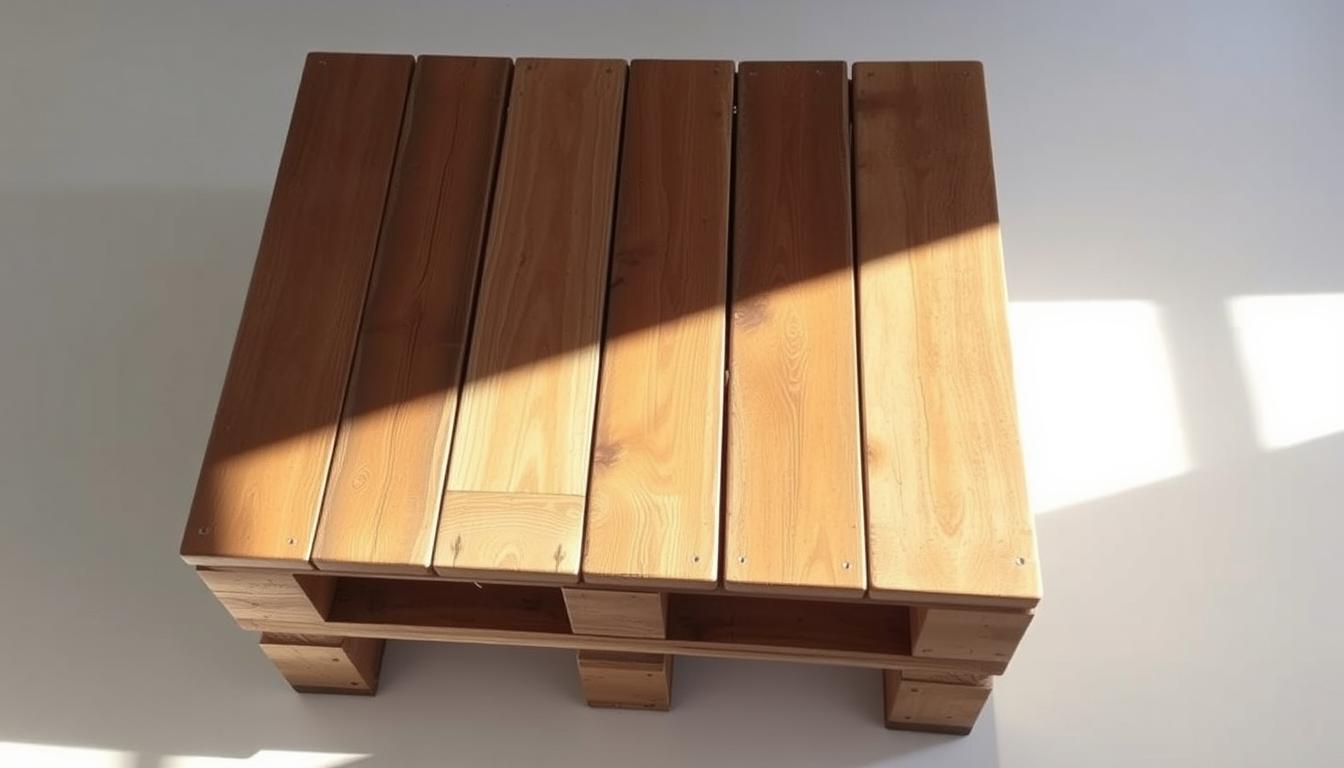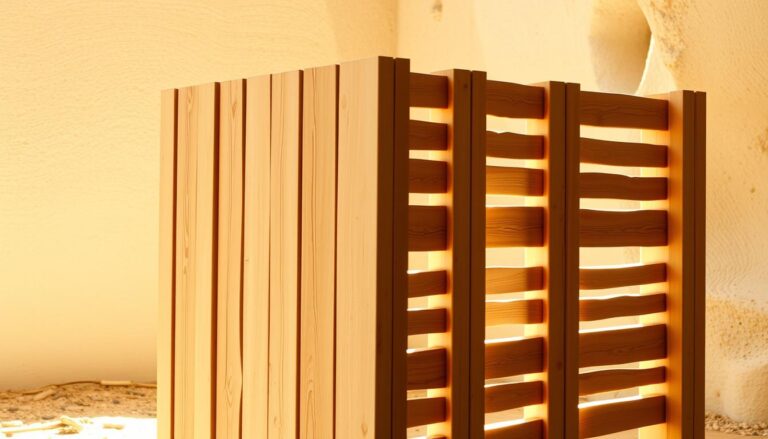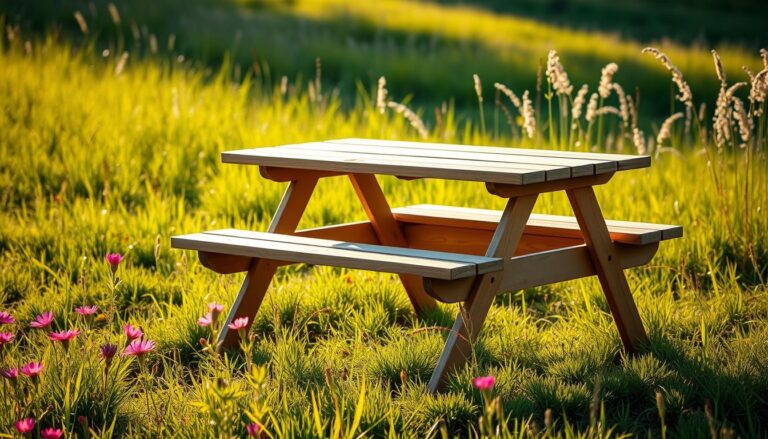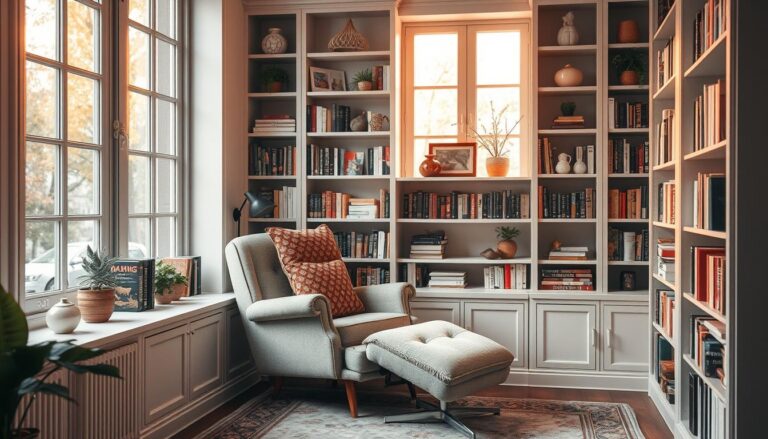Did you know over 2.5 billion pallets are used around the world each year? Many are tossed away after just one use. This fact shows the huge chance we have to turn old pallets into cool, useful furniture. Making a pallet coffee table is not only a fun DIY task but also a way to bring special, rustic style to your home without spending a lot.
In the steps that follow, we’ll show you how to change a simple pallet into an awesome coffee table. It will truly show off your personal taste. Let’s get started on this thrilling project of making furniture!
Understanding the Benefits of Pallet Furniture
Pallet furniture is gaining popularity for good reasons. It’s great for those who care about the environment and like DIY projects. This furniture type is all about being sustainable and adding a personal touch to your space.
Eco-Friendly Options
Many pallets are made from recycled wood, which is perfect for eco-friendly furniture. Choosing pallet furniture helps cut down on waste and lessens environmental harm. Using pallets for furniture proves a dedication to protecting our planet.
Cost-Effectiveness
Making furniture from pallets can save you a lot of money. It’s usually cheaper than buying furniture from a store. It’s a way to be stylish and smart with your money. You end up with unique pieces that don’t break the bank.
Unique Aesthetic Appeal
Pallet furniture brings a cozy and rustic vibe to any room. Every piece has its own stories, thanks to the wood’s unique grain and character. This kind of furniture lets you showcase your style, making each item truly special.
Choosing the Right Pallet
Starting your pallet coffee table project begins with choosing the right pallet. It’s important to learn about the different kinds of pallets you can use. You should also know where to find them and how to check them for safety and quality.
Different Types of Pallets
Different pallets have different uses in making furniture. Here are the main types:
- Standard Wood Pallets: Great for shipping, these pallets are also perfect for turning into furniture.
- Heat-Treated Pallets: These pallets are treated to kill pests, making them safe for home projects.
- Plastic Pallets: Though not as common in DIY, they’re durable and work well in damp areas.
Finding Pallets Near You
Looking for pallets can be fun. Here’s where to start:
- Look in local warehouses for unused pallets they might give away or sell cheaply.
- Stores often have pallets from deliveries and might let you take them for free.
- Online marketplaces and ads are good spots to find pallets.
Inspecting for Damage
Inspecting pallets is key for your project. Here’s what to check:
- Search for any broken boards that could affect the pallet’s strength.
- Inspect the corners and supports for weakness signs.
- Make sure there are no sticks-out nails or sharp bits that could hurt someone.
Tools and Materials Needed
Starting a DIY project, like making a coffee table from a pallet, means you need the right tools and materials. This makes building easier and ensures your table looks great. Here’s what you’ll need to begin.
Basic Tool List
- Hand saw or circular saw
- Hammer
- Nails or screws
- Sandpaper or an electric sander
These basic tools are key for making and finishing your coffee table. A quality saw cuts precisely. Sandpaper smooths rough edges, improving the table’s look.
Additional Materials for Finishing
To make your coffee table stand out, consider these for finishing touches:
- Wood stains
- Paints
- Sealants
These materials not only boost the appearance but protect the table too. They help it last longer.
Safety Gear Recommendations
Never underestimate the importance of safety in woodworking. You should consider the following safety gear:
- Gloves to protect your hands
- Safety goggles to safeguard your eyes
- Dust masks to filter out harmful particles
Wearing the right safety gear keeps you safe and prevents injuries while working.
Preparing the Pallet for Use
Getting the pallet ready is key for a successful project, like making a coffee table. You’ll need to clean, sand, and choose how to finish the pallet. Each step is crucial to match your design.
Cleaning the Pallet
First, clean the pallet well. Get rid of dirt, grime, or other stuff on it. Be careful with chemicals or residues. A clean pallet means your furniture will be safe to use and last longer.
Sanding Techniques
Then, it’s time to sand the wood. Begin with coarse sandpaper for rough spots. Then use finer sandpaper for a smooth finish. Sanding makes the pallet look and feel nice.
Staining vs. Painting
Choosing how to finish your pallet is important. Staining brings out the wood’s patterns and looks rustic. Painting gives you many color options for a bright look. Pick what fits your design best.
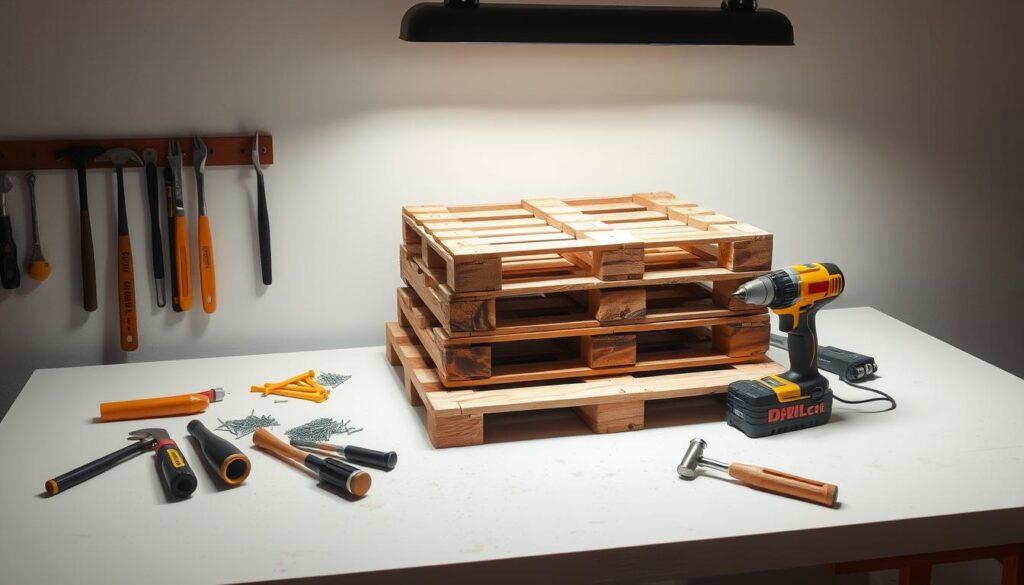
Designing Your Coffee Table
Turning a pallet into a coffee table lets you get creative with your design. You can show off your personal style while keeping it practical. Adding special features makes the table fit your needs better. Make sure to choose the right size so it fits well in your room.
Basic Coffee Table Designs
A simple pallet table can look great with its natural wood. If you like things simple, go for clean lines and a smooth top. Or mix modern styles with cool shapes and industrial materials. Each choice adds a different feel to your room with pallet furniture.
Customizing with Additional Features
Adding shelves or drawers to your table increases its use and storage. Think about adding wheels for moving it easily or a lift-top for hidden space. These extras make your table more useful and special to your room.
Considerations for Height and Size
It’s important to think about how big and tall your coffee table should be. Most are 16 to 18 inches high, matching well with sofas and chairs. Think about your room’s layout and how much table surface you need. A big table can be the main spot for get-togethers, but a smaller one might fit better in tight spaces. Always measure to make sure your table fits just right.
Assembling the Coffee Table
Putting together your coffee table needs careful attention and solid technique. Following steps will result in a great coffee table. Whether you’re a pro or new to this, our guide will help you step by step.
Step-by-Step Assembly Instructions
Start by arranging all materials and tools you’ll need. Make sure the pallets are clean and ready for assembly. Here’s how to start:
- Place the pallets for the tabletop so they fit nicely.
- Join the pallets with the right fasteners, using your DIY skills.
- If you want, reinforce the connections with woodworking joints.
- Make sure the table legs are straight and even.
Using Nails vs. Screws
It’s important to pick the right fasteners. Nails can make assembly fast, but screws hold things tighter and more securely. Think about this:
- Nails: Quick to use, good for short-term projects.
- Screws: Offer stronger hold, best for items you’ll use a lot.
Securing the Structure
After putting it together, make sure all joints and fasteners are tight. A strong build is key for safety. Adding brackets to corners can make it even more stable. This step can help your coffee table last longer.
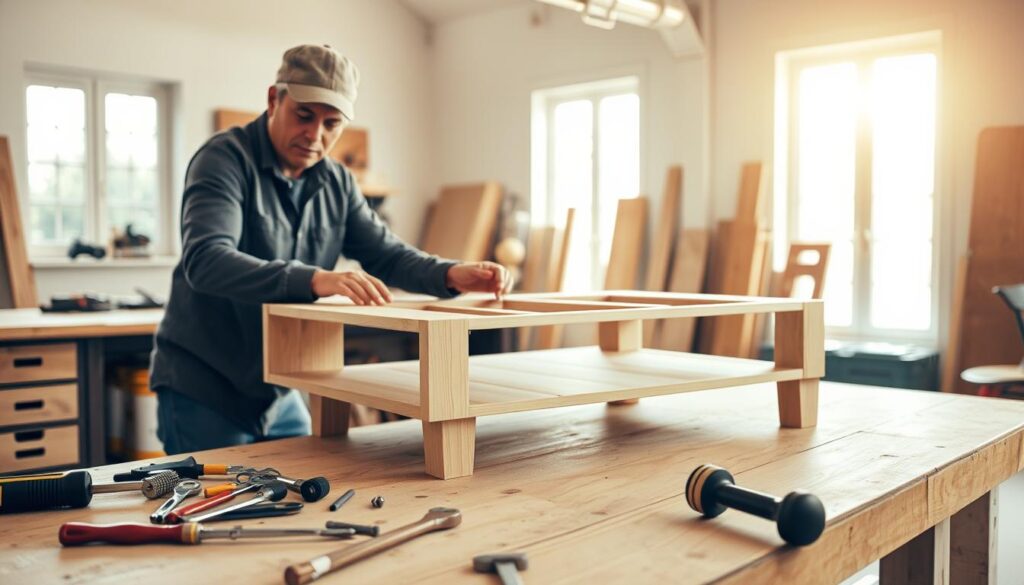
Adding a Finish to Your Table
Choosing the right finish for your pallet coffee table can make it look and last better. You have many wood finish options that can make your table unique and protect the wood. Knowing about different finishing techniques helps your table last longer.
Choosing the Right Finish
There are several wood finish options to consider. Options like oiling, varnishing, and polyurethane are popular. An oil finish brings out the wood’s natural beauty, while varnish makes it scratch-resistant. Polyurethane is very tough, perfect for tables used often.
Applying the Finish
Applying the finish correctly is key to a great look. Make sure the table is clean and smoothly sanded first. Then, apply the finish in thin, even layers, going with the wood grain. Let each coat dry thoroughly before adding another to avoid problems.
Drying and Curing Times
Each finish type has its own drying times for finishes. Oil finishes need about 24 hours to dry, but varnishes can take longer, especially with different weather. Polyurethane needs the most time to harden fully. Know these drying times to ensure your table’s best quality.
Incorporating Storage Solutions
When you design your pallet coffee table, think about how storage can improve both use and look. A great table is not just a focal point. It also provides smart ways to keep your space tidy. Here’s how to unlock that potential.
Adding Shelves or Drawers
Adding shelves or drawers makes your coffee table more useful. These parts create spots to hide things like magazines or blankets. Try using reclaimed wood to match your pallet and keep your stuff within reach.
Utilizing Decorative Baskets
Decorative baskets help control mess while looking good. Pick baskets in natural fibers for warmth or metallic for a modern vibe. They’re great for storing remotes, books, or odds and ends neatly.
Creative Storage Options
Thinking creatively can lead to tables that do more. For example, tables with lift-top lids hide storage while being stylish. It’s a smart way to manage your living area, blending looks with practicality.
| Storage Solution | Description | Benefits |
|---|---|---|
| Shelves | Open or enclosed shelves for easy access to items. | Enhances table functionality and maintains tidy organization. |
| Drawers | Hidden compartments for clutter-free storage. | Provides privacy for personal items. |
| Decorative Baskets | Stylish containers for organizing small items. | Adds decorative flair while keeping things tidy. |
| Lift-Top Design | Tabletops that lift to reveal hidden storage space. | Combines a coffee table with a storage solution. |
Decorating Your Coffee Table
Turning your coffee table into a key feature needs careful choice of decor. With the best accessories, your living space gets better. You keep it cozy but stylish. Here are key tips and ideas for making your coffee table look great.
Choosing the Right Accessories
When picking accessories for your coffee table, match them with its style. Go for items that show your taste, like:
- Natural materials: Use wood, stone, or ceramics for a natural vibe.
- Layered textures: Combine different fabrics with your decor.
- Unique shapes: Choose vases or bowls with various shapes to draw attention.
Seasonal Decoration Ideas
Change your coffee table’s look with each season for a fresh feel. Try these ideas:
- Spring: Add fresh flowers or pastel colors to lighten up your room.
- Summer: Beach themes, like seashells and sand hues, are perfect.
- Fall: Warm candles and small pumpkins set the autumn mood.
- Winter: Cozy up with pine cones and holiday ornaments for winter charm.
Tips for a Stylish Look
How you arrange things greatly affects your coffee table’s style. Achieve balance and warmth with these styling tips:
- Start with a big piece, like a unique bowl or books.
- Add smaller items, such as candles or pictures, around the main one to add depth.
- Make sure things vary in height and shape to keep it interesting, not boring.
- Keep some area open for use, making room for drinks or snacks during gatherings.
Maintaining Your Pallet Coffee Table
To keep your pallet coffee table looking great, clean it often. Use a soft, damp cloth for wiping. Avoid strong cleaners that can harm the wood. For a deeper clean, try a wood-safe cleaner. This keeps the wood looking beautiful.
Sometimes, your table might get scratched. Small marks can be fixed with a touch-up pen for wood. For bigger damage, furniture wax or wood filler helps. Also, using coasters helps protect your table from heat and scratches.
It’s good to check your table for damage now and then. Every few years, put new finish on it to keep it nice. This care keeps your coffee table beautiful and useful for a long time.

